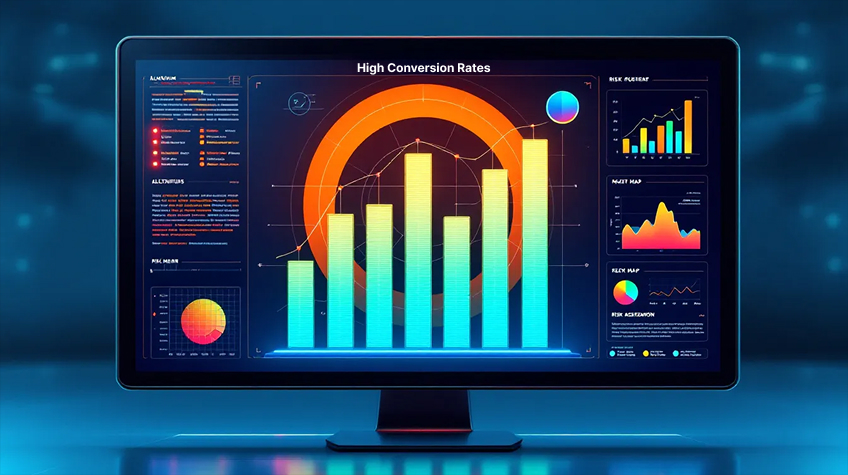
High conversion rates are essential for e-commerce businesses to succeed. When your website
can turn visitors into paying customers, you have the key to sustainable growth and profit.
Here’s something to think about: just a 1% increase in your conversion rate could mean
thousands of extra sales. This number shows how well your website is convincing visitors to do
what you want them to do – whether that’s buying something or signing up for a newsletter.
Why conversion rates matter for your business:

- More money is coming in without needing more people to visit
- Spending less on getting new customers
- Getting better results from your marketing efforts
- Keeping customers interested and involved
- Staying competitive in the market
The way you develop your e-commerce website is crucial in achieving these high conversion
rates. Every aspect, from how easy it is to use to how smooth the checkout process is, needs to
work together seamlessly to encourage visitors to make purchases.
In this detailed guide, you’ll learn about the best practices for creating an e-commerce website
that converts. These tried-and-true strategies have helped businesses in various industries
achieve impressive conversion rates, and now you’ll discover how to apply them successfully on
your platform.
Understanding Conversion Rate Basics

Your e-commerce conversion rate represents the percentage of website visitors who complete a
desired action, typically making a purchase. This crucial metric helps you measure your
website’s effectiveness in transforming browsers into buyers.
The Basic Calculation:
Conversion Rate = (Total Number of Conversions / Total Number of Visitors) × 100%
The average e-commerce conversion rate typically falls between 2% to 4%, though top-performing stores can achieve rates as high as 20%. These numbers vary significantly based on
Several key factors:
- Luxury goods: 0.6% – 1.4%
- Health and wellness: 2.02% – 3.1%
- Electronics: 1.4% – 2.9%
- Fashion: 1.8% – 2.4%
- Under $50: 2.5% – 3.5%
- $50-$200: 1.8% – 2.8%
- $200+: 0.8% – 1.5%
- Direct traffic: 2.9%
- Organic search: 2.4%
- Paid search: 1.9%
- Social media: 1.4%
- Desktop: 2.1% – 3.1%
- Mobile: 1.5% – 2.5%
- Tablet: 2.0% – 2.9%
- North America: 2.3%
- Europe: 1.9%
- Asia-Pacific: 1.7%
Understanding these benchmarks helps you set realistic goals and identify areas for
improvement in your e-commerce strategy. Your specific conversion rate targets should account
for your unique market position, product type, and target audience characteristics.
1. Enhancing User Experience and Design
A well-designed e-commerce website acts as your digital storefront, guiding visitors through a
seamless shopping journey. Let’s explore the key elements that create an engaging user
experience and drive conversions.
Your website’s navigation structure directly impacts purchase decisions. Create a clear category
hierarchies and implement these essential navigation elements:
- A prominent search bar with autocomplete functionality
- Filtered navigation options for product attributes
- Breadcrumb trails for easy backtracking
- Sticky navigation menus that follow users as they scroll
With 68% of e-commerce traffic coming from mobile devices, your site must deliver a flawless
mobile experience:
- Implement a responsive design that adapts to different screen sizes
- Use touch-friendly buttons and menus
- Optimize image sizes for faster mobile loading
- Place key elements within a thumb-reaching distance
- Design forms specifically for mobile input
High-quality visuals and compelling product descriptions create desire and boost conversion
rates:
- Display multiple product angles and zoom capabilities
- Include lifestyle photos showing products in use
- Write benefit-focused descriptions
- List technical specifications in scannable formats
- Add size charts and comparison tools
Strategic placement of trust signals helps overcome purchase hesitation:
- SSL certificates and security badges
- Customer reviews with verified purchase badges
- Clear shipping and return policies
- Real-time inventory status
- Payment method logos
- Money-back guarantee seals
Your CTAs should stand out and communicate value:
- Use contrasting colors for buttons
- Create urgency with action-oriented text
- Position CTAs above the fold
- Include micro-CTAs throughout product pages
- Test different button sizes and shapes
2. Optimizing the Checkout Process
Cart abandonment rates often reach 70% during checkout – a significant loss in potential
revenue. Understanding and addressing the key factors that drive customers away can
dramatically improve your conversion rates.
Common Checkout Abandonment Triggers:
- Unexpected shipping costs
- Mandatory account creation
- Complex, lengthy forms
- Limited payment options
- Security concerns
Your checkout form serves as the final bridge between browsing and buying. Streamline this
process by implementing these proven optimization techniques:
- Reduce form fields to essential information only
- Display a progress indicator for multi-step checkouts
- Auto-detect card types when entered
- Enable smart error detection with clear feedback
- Show shipping costs early in the process
Research shows that 23% of users abandon carts when forced to create an account. Guest
Check out options to remove this barrier while maintaining the ability to collect essential customer information
data. However, it’s important to address security concerns that may arise with guest checkouts.
You can still encourage account creation post-purchase by highlighting benefits like:
- Faster future purchases
- Order tracking capabilities
- Access to exclusive deals
- Saved shipping information
Amazon’s patent on 1-click purchasing has expired, opening new possibilities for e-commerce
sites.
Implementing one-click checkout can:
- Reduce checkout time by 60%
- Decrease cart abandonment rates
- Boost mobile conversion rates
- Improve customer satisfaction
Consider integrating popular express payment methods like Apple Pay, Google Pay, or PayPal to
provide a seamless checkout experience across all devices. These solutions automatically fill
shipping and payment details, reducing friction in the purchasing process.
3. Leveraging Social Proof and Urgency Tactics
Social proof transforms hesitant browsers into confident buyers by showcasing real customer reviews
experiences. Here’s how you can implement powerful social proof elements on your e-commerce site:
- Display star ratings prominently on product listings
- Include detailed customer reviews with photos and videos
- Highlight specific product features mentioned in positive reviews
- Showcase verified purchase badges to build trust
- Enable review sorting by rating, date, and relevance
- Show live purchase notifications (“Sarah from New York just bought this item”)
- Display current viewer counts (“15 people are viewing this product”)
- Indicate recent sales numbers (“50 sold in the last 24 hours”)
- Feature user-generated content in product galleries
- Display accurate stock levels for products
- Implement countdown timers for special offers
- Show “selling fast” indicators for popular items
- Add dynamic pricing alerts (“Price increases in 2 hours”)
- Use seasonal or event-based limited editions
- Alert users when products return to stock
- Send price drop notifications for wishlist items
- Display competitive pricing comparisons
- Show limited-time bundle deals
- Highlight exclusive member-only offers
These social proof elements work together to create a dynamic shopping environment that drives
purchase decisions through authentic customer validation and time-sensitive opportunities.
4. Personalization & Marketing Strategies for Higher Conversions
Personalized product recommendations create a tailored shopping experience that resonates with
your customers’ preferences and behaviors. You can implement AI-powered recommendations
engines that analyze:
- Purchase history
- Browsing patterns
- Similar customer profiles
- Cart contents
- Seasonal trends
These systems display relevant products through “Frequently Bought Together” sections,
personalized homepage suggestions, and targeted email campaigns. Research shows
personalized recommendations can increase average order value by up to 30%.
Strategic discount offerings drive conversions without sacrificing profit margins. Here’s a proven
discount framework:
- First-time buyer incentives: 10-15% off initial purchase
- Volume-based pricing: Bulk purchase discounts
- Free shipping thresholds: Set at 20-30% above average order value
- Loyalty rewards: Points-based systems with tiered benefits
- Cart abandonment offers: Time-sensitive discounts via email
You can enhance discount effectiveness by:
- Setting clear expiration dates
- Creating exclusive member-only deals
- Implementing seasonal promotions
- Using dynamic pricing based on inventory levels
Collecting zero-party data through quizzes and surveys enables hyper-personalized offers. This
approach builds customer trust while providing valuable insights for targeted marketing
campaigns.
5. Additional Tips for Maximizing E-Commerce Conversions
A 1-second delay in page load time can reduce conversions by 7%. Your e-commerce site needs
to load within 2-3 seconds to maintain user engagement. Implement these speed optimizations
techniques:
- Compress and optimize all images
- Enable browser caching
- Minify CSS, JavaScript, and HTML
- Use a Content Delivery Network (CDN)
- Choose a reliable hosting provider
Product pages with videos see 85% higher conversion rates than those without. Here’s how to
Leverage video content effectively:
- Create short, focused videos (60-90 seconds)
- Highlight key product features and benefits
- Show the product in real-world situations
- Include customer testimonials
- Add captions for accessibility
- Install a reliable site search function with auto-suggestions
- Enable real-time inventory tracking
- Set up automated cart abandonment recovery
- Implement live chat support during peak hours
- Use A/B testing to optimize page elements
Remember to monitor your site’s Core Web Vitals through Google Search Console and regularly
Test loading speeds across different devices and locations. Regular performance audits help
Identify potential bottlenecks affecting your conversion rates.
Conclusion
Implementing e-commerce website development best practices creates a powerful foundation for
achieving higher conversion rates. Each element – from user experience optimization to strategic
marketing tactics – plays a vital role in transforming casual browsers into loyal customers.
Your success in e-commerce depends on your commitment to:
- Creating seamless, user-friendly navigation
- Building trust through social proof and security measures
- Streamlining the checkout process
- Leveraging personalization and urgency tactics
- Maintaining fast loading speeds
- Using engaging product videos
Start by implementing these proven strategies one step at a time. Test each change, measure its
impact, and refine your approach based on your specific audience’s needs. Remember – high
conversion rates don’t happen by accident. They result from deliberate, thoughtful
implementation of e-commerce website development best practices.
Take action now. Your e-commerce success story begins with the first optimization step you
Choose to implement today






